Your Time has Finished
Which UCAT Exam
are you sitting?
Loading...
AR Type 3 Patterns
Your Score:
Average Score of All Users:
You performed better than of students
Section Breakdown
| Your Score | Average of all Users | Percentile | |
|---|---|---|---|
| Type 3 Patterns |
Type 3 Patterns
Your score:
Average score:
You performed better than of students
Abstract Reasoning Practice Subtest Instructions
There are 4 different question types in this section of the exam.
For type 1, you will be presented with two sets of shapes labelled “Set A” and “Set B”. You will be given a test shape and asked to decide whether the test shape belongs to Set A, Set B, or Neither.
For type 2, you will be presented with a series of shapes. You will be asked to select the next shape in series.
For type 3, you will be presented with a statement, involving a group of shapes. You will be asked to determine which shape completes the statement.
For type 4, you will be presented with two sets of shapes labelled “Set A” and “Set B”. You will be asked to select which of the four response options belongs to Set A or Set B.
It is in your best interest to answer all questions as there is no penalty for guessing. All unanswered questions will be scored as incorrect.
Click the Next (N) button to proceed.
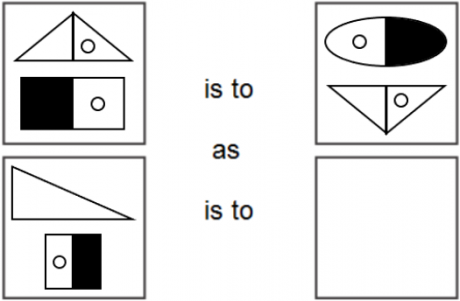
Explanation
The correct answer is C – The top triangle must be flipped horizontally (as in C and D). The top half should contain a circle, not an oval (reflecting the rounding of the square, not a rectangle).
Pattern: The shapes in the top and bottom halves swap positions. The shape from the top half is flipped horizontally, whilst the shape from the bottom half is flipped vertically (or rotated 180 degrees) and rounded off.
Method: Focus on the obvious point of similarity, namely that the triangle in the top half of Box 1 appears upside-down in the bottom half of Box 2. This makes it easier to deal with the bottom half of Box 1, which correspondingly gets moved into the top half of Box 2, only that it gets flipped vertically, and rounded off.
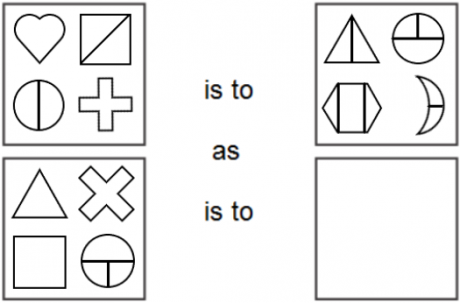
Explanation
The correct answer is D – We are looking for shapes with 2 regions in every position other than the bottom-right, where we are looking for a shape with 4 regions.
Pattern: The shape in each position gets one additional internal region. The shape itself can change.
Method: Observe that the “shapes” (even though they change) with the most internal regions in Box 1 also have the most internal regions in Box 2 – the shape in the top-right goes from two to three, whilst the shape in the bottom-left goes from one to two. All in all, it should soon become clear that the shape in each position gains one internal region. You should expect each shape to change, though there’s nothing to suggest that this must happen.
 lol
Medicmind Tutor
lol
Medicmind Tutor
Thu, 23 Sep 2021 04:57:31
a bit easy

Explanation
The correct answer is A – We seek a square inside a rectangle, as in A, B and C. However, the bottom rectangle should look identical because it will be flipped horizontally. This means A must be the correct answer, revealing that the pattern is for colours to switch between white and black.
Pattern: The top shape ends up inside a larger version of the bottom shape, which is inverted. The question alone does not make it clear whether the shapes swap colours with each other or merely swap between white and black – however, we can tell this from the available answers.
Method: Concentrate on Shape first – clearly, the top shape ends up inside the bottom shape, although, as is explained above, you cannot tell without the answer options what the rule on Colour is.
 anon
Medicmind Tutor
anon
Medicmind Tutor
Tue, 03 Aug 2021 00:35:27
how can it be A if the top shape goes inside the bottom shape? that would mean B is correct as that looks more like a square inside a rectangle
 J
Medicmind Tutor
J
Medicmind Tutor
Wed, 11 Aug 2021 14:11:30
It is A because both shapes are black, so you can't see the square inside.
 Alireza G.
Medicmind Tutor
Alireza G.
Medicmind Tutor
Thu, 23 Sep 2021 04:57:59
A Bit easy
 oh
Medicmind Tutor
oh
Medicmind Tutor
Sun, 26 Sep 2021 13:55:35
oh i get it now
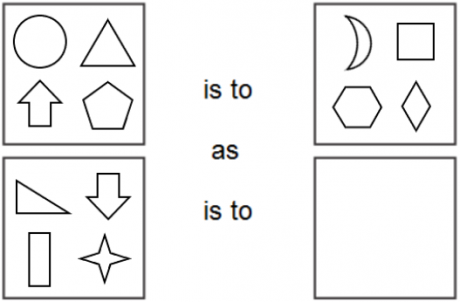
Explanation
The correct answer is A – Top half: 4 and 8; bottom half: 3 and 7.
Pattern: The two shapes in the top half gain a side; those in the bottom half lose a side.
Method: We go from four white shapes in Box 1 to four white shapes in Box 2, and none of the shapes remains the same per se. Thus, it seems reasonable to ignore Size, Position, Orientation and Colour. Focussing on Number/Shape, then, the pattern should soon reveal itself.
 Alireza G.
Medicmind Tutor
Alireza G.
Medicmind Tutor
Thu, 23 Sep 2021 05:00:35
Still A Bit easy
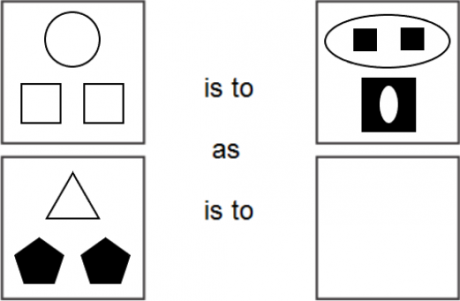
Explanation
The correct answer is C – The answer must have only white pentagons and only white triangles – only C satisfies this (along with the other conditions of the pattern.
Pattern: The top shape elongates horizontally, staying in position and containing copies of the two shapes in the bottom half. Meanwhile, one of the shapes in the bottom half contains a vertically-elongated version of the top shape. Finally, the shape from the bottom half changes colour between white and black, whilst the shape from the top half retains its colour.
Method: Confusing as the pattern seems, the best we can do is to focus on what is inside Box 1 and where it ends up in Box 2. A rounded shape appears twice in Box 2, and only once in Box 1, and so we can infer that the shape in the top half gets stretched horizontally, whilst a vertically-elongated version (or better, a horizontally-compressed version) of the top shape appears in the bottom half of Box 2. Focussing then on the identical shapes in the bottom half, they evidently change colour, and appear internally in Box 2’s top half and externally in Box 2’s bottom half.
 Alireza G.
Medicmind Tutor
Alireza G.
Medicmind Tutor
Thu, 23 Sep 2021 05:01:37
A little Bit easy

Explanation
The correct answer is B – Only C and D have the right shapes in the right positions. In D, every shape’s colour changes, rather than all shapes excluding the left-middle and right-middle positions.
Pattern: The three shapes along the top-left-to-bottom-right diagonal rotate slightly clockwise. The two leftmost shapes along the bottom row swap positions with the two rightmost shapes along the top row. Every shape changes colour between black and white, except for those in the left-middle and right-middle positions.
Method: Isolate the larger shapes along the top-left-to-bottom-right diagonal – evidently, these rotate and switch between white and black. Of the remaining shapes, those in the middle-left and middle-right positions do not change; the last four swap shape and colour.
 sissi
Medicmind Tutor
sissi
Medicmind Tutor
Sun, 15 Aug 2021 10:41:37
took me almost half an hour to figure this one out on my own gosh
 Yopi
Medicmind Tutor
Yopi
Medicmind Tutor
Sun, 19 Sep 2021 09:27:58
i know it's not the rule but i put answer d cause the colours are inverted then mirrored but it wasn't right
 yuh
Medicmind Tutor
yuh
Medicmind Tutor
Sun, 26 Sep 2021 13:56:37
same i did think the same rule as you sissi
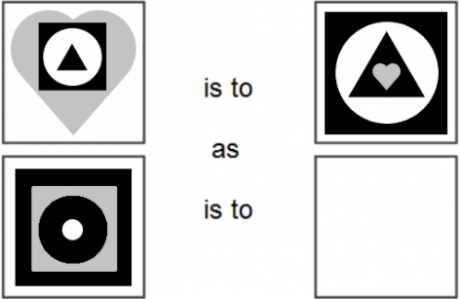
Explanation
The correct answer is D – The outer black square will become the innermost shape, followed by the white circle, black circle and grey square.
Pattern: Every shape moves outwards one position, the outermost shape coming into the innermost spot.
Method: Concentrate on the outermost shape in Box 1, the grey heart, which ends up innermost in Box 2. This is the key to identifying this very characteristic Type 3 Question pattern.
Wed, 22 Sep 2021 09:39:29
A Bit easy